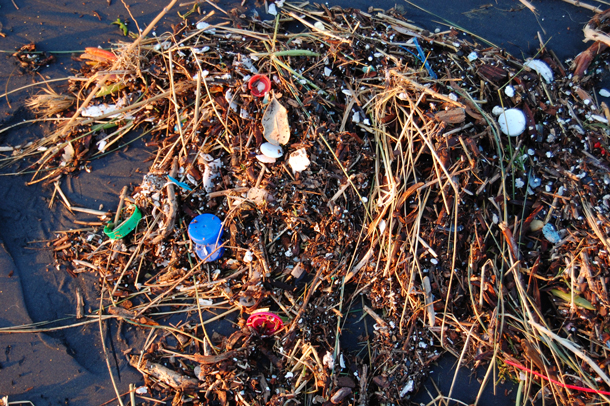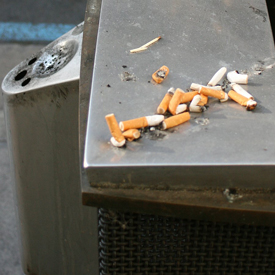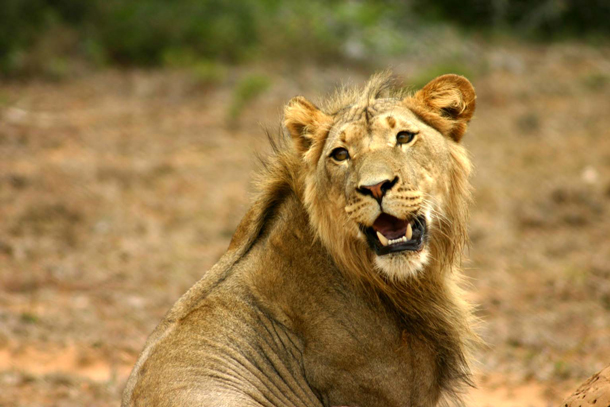Beyond the Headlines
Air Date: Week of April 12, 2019

Plastics entangled within marine vegetation that washed up on Ocean Beach in San Francisco. (Photo: Kevin Krejci, Flickr, CC BY 2.0)
This week in beyond the headlines, Peter Dykstra joins host Steve Curwood to discuss good and bad news about plastics in the oceans and freshwater. The conversation continues with the story of a rhino poacher in a South African park trampled to death by an elephant and later eaten by a pride of lions. Then they look back in the history calendar to discuss the 40th anniversary of the Environmental Protection Agency’s formal ban of the manufacture of polychlorinated biphenyls (PCBs).
Transcript
CURWOOD: Let's take a look beyond the headlines now with Peter Dykstra. He's an editor with environmental health news, ehn.org. Daily climate.org. He's joining us on the line from Atlanta. Hi there, Peter, what's going on?
DYKSTRA: Hi, Steve. There were two reports that came out this past week. One, a peer reviewed science report in the journal marine pollution bulletin and the other from two NGOs, on marine plastics and our waterways. The first one from marine pollution bulletin and it says that between 4.8 to 12.7 million metric tons of plastic pollution have been dumped into the world's oceans. And they tried to set a cost for the global economy from lost species, potential damage to human health and of course, losses to fisheries. Their rough guess is $2.5 trillion a year only set to go up every year.
CURWOOD: And, what about the other study?
DYKSTRA: The other study is the plastic rivers report from Earthwatch Europe, and another one from plastic oceans UK, I guess we have to get used to setting the UK and Europe apart from each other. The way that the UK is trying to do with Brexit right now. They said they gave us some good news. Plastic bags were down to only 1% of the plastic garbage in fresh water and that they think is a reflection of a long-time effort to reduce the amount of plastic bags used in grocery stores and other things. The bad news out of that is that other forms of plastic are still riding high. Plastic bottles are now number one, food wrappers are number two, and number three are cigarette butts. A little bit of good news though those plastic bags, apparently because of human Consumer Action are on the way down.

About 90 percent of cigarette filters contain plastic, and cigarette butts are often the most littered item. (Photo: Stephen Mitchell, Flickr, CC BY 2.0)
CURWOOD: And I never knew cigarette butts had plastic in them. But hey, you learn something every time.
DYKSTRA: A lot of cigarettes and it’s an addictive thing. They are a negative renewable resource, I guess.
CURWOOD: Hey, what else do you have for us this week, Peter?
DYKSTRA: It's a little three-part drama involving three charismatic megafauna species in South Africa's Kruger National Park. Kruger is famous for the wildlife that's there. They are also famous for wildlife tourism, but they also still have approaching problem there was recently a rhino poacher who was reportedly stomped to death by elephants, and then eaten by lions.
CURWOOD: That certainly does sound like a bit of charismatic megafauna karma. Is that the way to put it?
DYKSTRA: This all took place in a section of the Kruger Park called crocodile bridge. It would be even more karmic if you could get the crocodiles in on it.
CURWOOD: And how do we know this is so?
DYKSTRA: Well there were four other Rhino poachers who came out but they ended up arrested by Game Wardens. They told the tale. And this is also not without precedent. A few months ago, there was a report of three Rhino poachers that were eaten by lions at a private South African Game Reserve elsewhere in the country.
CURWOOD: Interesting and I gather to protect rhinos there they're forcing poachers to operate at night. And of course, that's when lion hunt!

A lion in Addo Elephant Park, South Africa. (Photo: Charles Sharp, Flickr, CC BY 2.0)
DYKSTRA: That's when lions hunt and I guess poachers are apparently delicious.
CURWOOD: All right, time now for us to go back in history a ways. What do you see?
DYKSTRA: We're going to look at a 40th anniversary from April 19,1979. That's when the US EPA formally banned the manufacturer of polychlorinated biphenyls PCBs.
CURWOOD: Yeah, those are really nasty chemicals that are chemical cousins actually of dioxins.
DYKSTRA: They're nasty. They're carcinogens. And one of the problems is that they're extremely long lasting. Even though PCBs have not legally been made in this country for 40 years. They're used an electrical transformers, GE and other companies dump them in places like New Bedford harbor not far from you the Hudson River. There's also a huge PCB problem 40 years later, in Waukegan harbor and lake Michigan, Illinois,
CURWOOD: They not only are in the water, but then they show up in the bodies, particularly of marine mammals seem to have high levels of PCBs to this day.
DYKSTRA: They can show up in salt water in in marine mammals, and they'll show up in freshwater in sport and commercial fish, like striped bass. The Hudson River is teeming with striped bass right now; people don't catch them because you're not allowed to eat them.
CURWOOD: And what's the body burden of PCBs for humans?
DYKSTRA: PCBs continue to be long lasting and continue to show up in human tissue samples, even after the last ones were made 40 years ago. That's because PCBs are believed to last in a toxic and carcinogenic form for possibly hundreds of years.
CURWOOD: Thanks, Peter. Peters’ an editor with Environmental Health News. That's ehn.org and dailyclimate.org. We'll talk to you again real soon.
DYKSTRA: Okay, Steve, thanks a lot. Talk to you soon.
CURWOOD: And there's more on these stories at our website loe.org.
Links
The Weather Network | “Marine Plastic Pollution Costs Up to $2.5 Trillion Per Year”
Living on Earth wants to hear from you!
Living on Earth
62 Calef Highway, Suite 212
Lee, NH 03861
Telephone: 617-287-4121
E-mail: comments@loe.org
Newsletter [Click here]
Donate to Living on Earth!
Living on Earth is an independent media program and relies entirely on contributions from listeners and institutions supporting public service. Please donate now to preserve an independent environmental voice.
NewsletterLiving on Earth offers a weekly delivery of the show's rundown to your mailbox. Sign up for our newsletter today!
 Sailors For The Sea: Be the change you want to sea.
Sailors For The Sea: Be the change you want to sea.
 The Grantham Foundation for the Protection of the Environment: Committed to protecting and improving the health of the global environment.
The Grantham Foundation for the Protection of the Environment: Committed to protecting and improving the health of the global environment.
 Contribute to Living on Earth and receive, as our gift to you, an archival print of one of Mark Seth Lender's extraordinary wildlife photographs. Follow the link to see Mark's current collection of photographs.
Contribute to Living on Earth and receive, as our gift to you, an archival print of one of Mark Seth Lender's extraordinary wildlife photographs. Follow the link to see Mark's current collection of photographs.
 Buy a signed copy of Mark Seth Lender's book Smeagull the Seagull & support Living on Earth
Buy a signed copy of Mark Seth Lender's book Smeagull the Seagull & support Living on Earth

